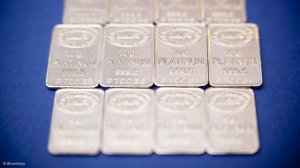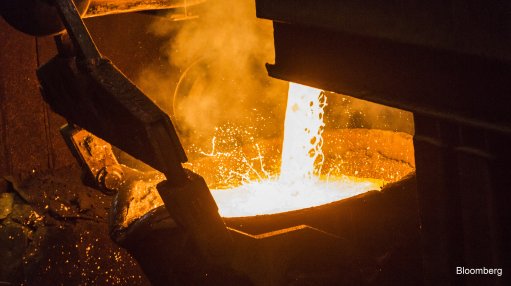SA’s platinum production down 20% in eight years, similar slide expected in next three years



CHALLENGING TIMES Metal price declines, in addition to the local labour, energy and political challenges, is placing further pressure on many already beleaguered PGMs miners
Photo by Bloomberg
JEFFREY CHRISTIAN CPM Group predicts that the platinum price will improve to about $1 250/oz by 2017, largely as a result of production shortfalls
Platinum production has declined by 20% in South Africa over the past eight years, with predictions this will decrease by a further 15% to 20% beyond the next two to three years, says New York-based research and consulting firm CPM Group MD Jeffrey Christian.
He tells Mining Weekly it is highly likely that this production decline, according to CPM Group’s research projections, will cause a supply shortfall, which will improve the platinum prices in the long run. He says before this happens, however, prices may stagnate between current lows and levels around $1 250/oz by 2017.
The mining industry in South Africa flourished in the early 2000s when the rand was devaluing, prices of platinum-group metals (PGMs) were rising strongly, fabrication demand was strong and there was a lot of investment in the sector, Christian adds.
However, he notes that many PGMs miners watched their operating costs increase by about 15% a year for about ten years because the devaluing rand and the price appreciation of these metals helped cover these cost increases.
Nevertheless, Christian points out that, over the past four to five years, the decline in the value of the rand, along with PGMs prices has come back to haunt many PGMs producers, particularly those that were not implementing cost-reduction strategies at the time.
Local labour, energy and political challenges are placing further pressure on many already beleaguered PGMs miners.
CPM Group research director Rohit Savant says there is a global slowdown in platinum demand, while palladium demand is not as robust as it was two to three years ago.
“The decline in platinum demand is mainly tied to the slowdown in the automotive sector, which largely uses it for catalytic converters.”
Savant notes the rise in popularity of selective reduction catalysts (SRCs), which use urea – a carbamide organic compound – as an alternative to platinum. SRCs are increasingly used in new trucks and buses instead of standard platinum-based catalytic converters, as they are significantly cheaper.
Further, platinum is also used to make jewellery (rings) and this market has also been under significant pressure over the past two to three years, which has contributed to the decline in platinum demand, Savant points out.
CPM Group believes that, over the next three to five years, jewellery demand should start improving, owing to weak global platinum prices. Savant says this will assist in offsetting, to some extent, the slowdown in demand for platinum in catalytic converters.
“We do not foresee a slowdown in fabrication demand over the next three to five years, but we also do not predict any substantial growth in the sector. Therefore, we predict that demand will remain flat,” he states.
Savant states that the outlook for palladium demand is a little better. Although it is also used in the automotive market, particularly for catalytic converters, its use in this sector is growing versus stagnant platinum use in the auto sector. Further, palladium is also used for electronics, which is a growing industry.
However, he notes that the electronics industry has been reducing the amount of palladium used to manufacture electronics over the past several years to reduce costs by using alternative cheaper materials such as silver alloys.
The per unit reduction of palladium in electronics is offset by the increase in the unit volumes of electronic products being manufactured globally.
Savant also points out that the significant increase in recycled palladium from catalytic converters over the past five years is also reducing the need for primary supplies of mined palladium, which is impacting negatively on not only demand supply volumes for PGMs miners but also the price of PGMs.
Investors are well aware of the state of the PGMs market; however, they are not necessarily abandoning the sector, but there is definitely a sense of caution among them, he comments.
“Even if one considers the net additions to the exchange-traded funds, they are significantly smaller than they were five years ago. This is also weighing on PGMs prices.”
Savant says the PGMs sector is likely to experience supply shortfalls beyond the next two to three years, owing to the significant spending reductions at existing and new PGMs mining operations.
However, regarding PGMs demand, he states that weak prices will create a reduction in the need for manufacturers to scale back on the amount of PGMs they use in products.
“We may also see that if PGMs prices remain weak, new uses will develop for PGMs in the medium to long term.”
Savant stresses that, despite the challenges the PGMs sector faces, there is a future for the metals globally.
“However, mining and metals trading companies must take prudent measures to ensure they overcome the current challenging metals pricing climate to be in a position where they can benefit when prices rise again. This will invariably happen and will most likely be tied to increased demand for PGMs in the Chinese and the US automotive and jewellery sectors,” he concludes.
Comments
Press Office
Announcements
What's On
Subscribe to improve your user experience...
Option 1 (equivalent of R125 a month):
Receive a weekly copy of Creamer Media's Engineering News & Mining Weekly magazine
(print copy for those in South Africa and e-magazine for those outside of South Africa)
Receive daily email newsletters
Access to full search results
Access archive of magazine back copies
Access to Projects in Progress
Access to ONE Research Report of your choice in PDF format
Option 2 (equivalent of R375 a month):
All benefits from Option 1
PLUS
Access to Creamer Media's Research Channel Africa for ALL Research Reports, in PDF format, on various industrial and mining sectors
including Electricity; Water; Energy Transition; Hydrogen; Roads, Rail and Ports; Coal; Gold; Platinum; Battery Metals; etc.
Already a subscriber?
Forgotten your password?
Receive weekly copy of Creamer Media's Engineering News & Mining Weekly magazine (print copy for those in South Africa and e-magazine for those outside of South Africa)
➕
Recieve daily email newsletters
➕
Access to full search results
➕
Access archive of magazine back copies
➕
Access to Projects in Progress
➕
Access to ONE Research Report of your choice in PDF format
RESEARCH CHANNEL AFRICA
R4500 (equivalent of R375 a month)
SUBSCRIBEAll benefits from Option 1
➕
Access to Creamer Media's Research Channel Africa for ALL Research Reports on various industrial and mining sectors, in PDF format, including on:
Electricity
➕
Water
➕
Energy Transition
➕
Hydrogen
➕
Roads, Rail and Ports
➕
Coal
➕
Gold
➕
Platinum
➕
Battery Metals
➕
etc.
Receive all benefits from Option 1 or Option 2 delivered to numerous people at your company
➕
Multiple User names and Passwords for simultaneous log-ins
➕
Intranet integration access to all in your organisation




















